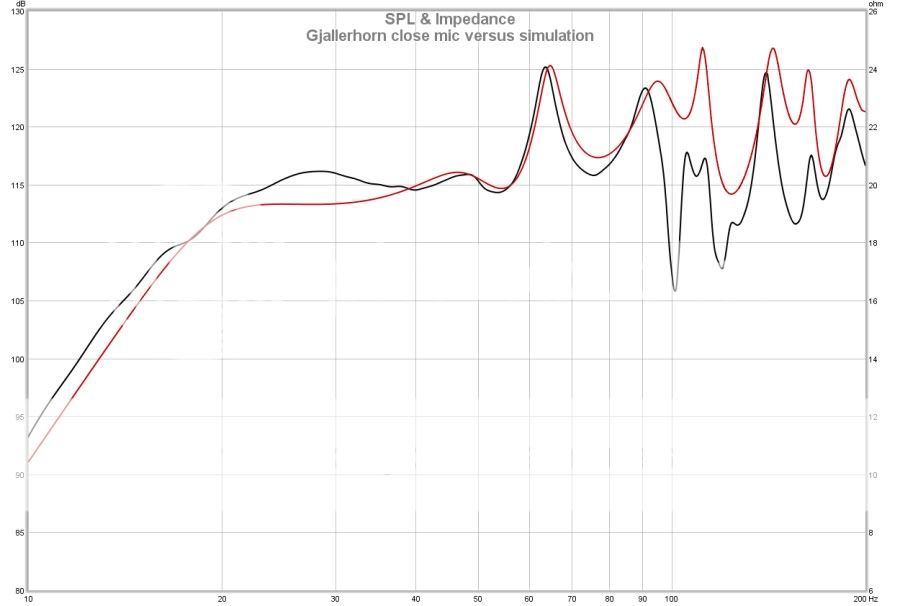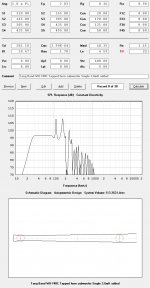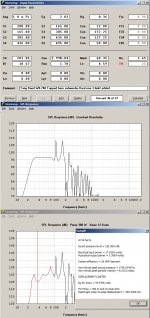I know you know a lot more than me brian, so please dont take anything I'm saying the wrong way, its your knowledge and a that of a number of others here thats basically taught me anything.
as far as the resonances go, one of the most well regarded DIY low tuned THs available in these parts (gjallerhorn) displays the same problems, with 3 peaks almost 10 db up from passband average (the lowest being at 65 hz, WAY in the passband).
http://www.diyaudio.com/forums/subwoofers/189784-gjallerhorn.html#post2585737

the TH Spud itself displays a similar, 10 db jump, starting at 75hz and continuing above 110 hz.
http://www.diyaudio.com/forums/subwoofers/134369-dual-8-tapped-horn-th-spud-11.html#post2046436

So I dont see how this is a major design flaw? I actually tried to design it to push the spikes outside of the passband (instead of inside around 70 to 80 like seen in those 2 examples.
as far as the resonances go, one of the most well regarded DIY low tuned THs available in these parts (gjallerhorn) displays the same problems, with 3 peaks almost 10 db up from passband average (the lowest being at 65 hz, WAY in the passband).
http://www.diyaudio.com/forums/subwoofers/189784-gjallerhorn.html#post2585737

the TH Spud itself displays a similar, 10 db jump, starting at 75hz and continuing above 110 hz.
http://www.diyaudio.com/forums/subwoofers/134369-dual-8-tapped-horn-th-spud-11.html#post2046436

So I dont see how this is a major design flaw? I actually tried to design it to push the spikes outside of the passband (instead of inside around 70 to 80 like seen in those 2 examples.
So I dont see how this is a major design flaw? I actually tried to design it to push the spikes outside of the passband (instead of inside around 70 to 80 like seen in those 2 examples.
I didn't say it was a "design flaw". I said that it would need quite a bit of processing to deal with it. e.g. a simple 12dB/oct low-pass filter may not be enough to get the best results.
thanks for that link TB (sorry, my six key doesnt work so I'll never be able to spell your name out lol). I've been looking for it.
The THspud seems to dig a bit lower than I need, and is about 375 liters for 2 8s, I'd like to stuff 4 8s in that space if possible. I realize I'll likely only be able to get response down to about 20 to 25hz rather than the 15 or so hz the spud goes to. It has like a six hundred and 20 cm path length, about 150 more cm than I think I am really willing to go.
I dont think I can beat the spud, but then again i'm not trying to compete with it ;p
GM, I missed your second post. checking it out now!!!!
Try this. It is a smaller TH-Spud style horn that still uses two Tang Band W8-740 drivers. An Erse 3.6mH coil helps flatten the response out.
Attachments
Try this. It is a smaller TH-Spud style horn that still uses two Tang Band W8-740 drivers. An Erse 3.6mH coil helps flatten the response out.
I worked out the folding for this horn. A few things changed due to practical considerations and fitment requirements. The resulting Horn Response parameters reflect the required changes. The exterior dimensions are 11 5/16" (28.7cm) deep X 27" (68.7cm) wide X 38" (96.3cm) tall. Total folded volume is 6.7 cu. ft. or 189.86 liters. I think this is a lot of horn in a pretty reasonable sized package. Panel thickness used is 19mm or ¾”. An Erse 3.6mH coil is added and the Tang Band W8-740 woofers are wired in series for an 8 ohm load. An amplifier capable of 500Wrms into 8 ohms should be more than enough. Its Max SPL level well exceeds THX standards. I'm seriously considerenig building a pair of these once the weather clears up.
Attachments
I worked out the folding for this horn. A few things changed due to practical considerations and fitment requirements. The resulting Horn Response parameters reflect the required changes. The exterior dimensions are 11 5/16" (28.7cm) deep X 27" (68.7cm) wide X 38" (96.3cm) tall. Total folded volume is 6.7 cu. ft. or 189.86 liters. I think this is a lot of horn in a pretty reasonable sized package. Panel thickness used is 19mm or ¾”. An Erse 3.6mH coil is added and the Tang Band W8-740 woofers are wired in series for an 8 ohm load. An amplifier capable of 500Wrms into 8 ohms should be more than enough. Its Max SPL level well exceeds THX standards. I'm seriously considerenig building a pair of these once the weather clears up.
Switch the expansion from "CON" to "PAR" for a more accurate sim of a horn folded up into a rectangular box.
Switch the expansion from "CON" to "PAR" for a more accurate sim of a horn folded up into a rectangular box.
I tried your suggestion. It virtually made no difference. I can barely see the difference when I do the "compare previous" command. Historically, my Horn Response predictions have measured very close using Conical sections for the simulation. Is there a significant reason for your suggestion? Did I miss a conversation somewhere?
JLH, your sim is nice (very flat), but it seems to have VERY similar output capabilities to a half of the sime I posted on page one (http://www.diyaudio.com/forums/subw...pped-horns-long-path-lengths.html#post3818366 (I posted a 4 driver design, by showing graphs of 2 2p designs in 2S).
They are withing about 1 db of each other if both are graphed in 1 pi, and are the same size (140 liters pre fold).
the conical vs Par thing might be more relevant when working with a larger horn.
They are withing about 1 db of each other if both are graphed in 1 pi, and are the same size (140 liters pre fold).
the conical vs Par thing might be more relevant when working with a larger horn.
Last edited:
Is there a significant reason for your suggestion? Did I miss a conversation somewhere?
Expansion in a horn which has two parallel sides (basically almost every horn folded into a rectangular enclosure) is parabolic, not conical. A search for "parabolic" on this forum should turn up the message threads where this has been discussed.
I tried your suggestion. It virtually made no difference. I can barely see the difference when I do the "compare previous" command. Historically, my Horn Response predictions have measured very close using Conical sections for the simulation. Is there a significant reason for your suggestion? Did I miss a conversation somewhere?
As long as none of the segments are extremely long it won't make a significant difference in your graphs (depending on how you define "significant", I guess). It will, however, make quite a big difference in the net volume reported on the Schematic screen.
I noticed that the specs you used are not even close to the published specs, are they measured specs? If so, what was the Le? 1.8 less than shown?
EDIT - a quick search for your name and keyword w8-740 shows these are measured specs, and Le is 2.8 before adding 1.8 mh of extra inductance, as I thought. I just wanted to make sure I was following what you were doing.
Last edited:
As long as none of the segments are extremely long it won't make a significant difference in your graphs (depending on how you define "significant", I guess). It will, however, make quite a big difference in the net volume reported on the Schematic screen.
I noticed that the specs you used are not even close to the published specs, are they measured specs? If so, what was the Le? 1.8 less than shown?
EDIT - a quick search for your name and keyword w8-740 shows these are measured specs, and Le is 2.8 before adding 1.8 mh of extra inductance, as I thought. I just wanted to make sure I was following what you were doing.
You got it correct.
Edit - Changing to Par only added 0.83 liters to the horn volume. That's not significant in my book.
Last edited:
They are withing about 1 db of each other if both are graphed in 1 pi, and are the same size (140 liters pre fold).
The pre fold volume on my horn is 115 liters, not 140 liters.
Changing to Par only added 0.83 liters to the horn volume. That's not significant in my book.
No, it's not. Usually there's quite a bit more discrepancy when switching from CON to PAR but I guess not in this case. I just use PAR when possible to avoid the issue. I have noticed that the larger the segments are the more difference there will be between CON and PAR, especially if the segments are long, and that's as far as I have studied this issue. For example, if the segment is ridiculously large you can see a difference of 1/3 volume. http://www.avsforum.com/t/1489784/h...e-vs-advanced-centerline-method#post_23714999 - no need to read that, just look at the pictures. And I've noticed a fair bit of discrepancy with regular sized segments too, if the segment is very long like the middle segment in most constant expansion rate tapped horns. And the issue isn't volume alone, but a discrepancy in how the volume is distributed within the segment, since CON and PAR are very different shapes and this can lead to differences in the sim. But as long as the segments are very short this isn't a huge issue, I just like to be as accurate as possible.
Last edited:
No, it's not. Usually there's quite a bit more discrepancy when switching from CON to PAR but I guess not in this case. I just use PAR when possible to avoid the issue. I have noticed that the larger the segments are the more difference there will be between CON and PAR, especially if the segments are long, and that's as far as I have studied this issue. For example, if the segment is ridiculously large you can see a difference of 1/3 volume. Horn Folding - a brief study of the centerline vs advanced centerline method - no need to read that, just look at the pictures. And I've noticed a fair bit of discrepancy with regular sized segments too, if the segment is very long like the middle segment in most constant expansion rate tapped horns. And the issue isn't volume alone, but a discrepancy in how the volume is distributed within the segment, since CON and PAR are very different shapes and this can lead to differences in the sim. But as long as the segments are very short this isn't a huge issue, I just like to be as accurate as possible.
Thank you for the detailed followup.
GM, your design is the MCM 8 correct? doesnt it only have 8mm of xmax?
Correct.
The data sht. I have lists a 16 mm Xmax, but Hc, Hg specs calculates only 8 mm, so all my 55-2421 Xmax sims are ~ 6 dB too optimistic.
GM
- Status
- This old topic is closed. If you want to reopen this topic, contact a moderator using the "Report Post" button.
- Home
- Loudspeakers
- Subwoofers
- Good 8" drivers for Tapped horns with long path lengths?

